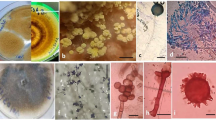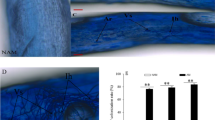Abstract
This study investigated the cellular and subcellular compartmentation of Ni in the Eurasian serpentine species Alyssum murale, Alyssum bracteatum and Cleome heratensis and a non-serpentine population of A. murale (as a control) grown in hydroponic culture. Plant growth responses and Ni uptake clearly revealed the higher Ni tolerance of serpentine plants than the non-serpentine plants. Serpentine A. murale and A. bracteatum grew better at elevated (0.01 mM) Ni in the nutrient solution, supporting the view that the Ni hyperaccumulators have a higher requirement for Ni than normal plants. Low shoot Ni content of C. heratensis in response to the high Ni treatments indicated that this species employs an avoidance strategy for Ni tolerance. Energy-dispersive X-ray microanalysis showed that Ni was highly concentrated in the cell walls and cell lumen, most likely the vacuoles, of leaf epidermis of A. murale and A. bracteatum rather than in the mesophyll cells. EDX spectra from leaves of the non-serpentine A. murale suggested that Ni accumulated in both epidermal and mesophyll cells but not in the epidermal cell walls. Growth reduction and Ni toxicity in plants of the non-serpentine A. murale could be due to accumulation of Ni in the lumen of leaf mesophyll cells. Our data suggest that cellular and subcellular compartmentation are both possible mechanisms for Ni tolerance employed by the serpentine A. murale and A. bracteatum.








Similar content being viewed by others
Abbreviations
- EDX:
-
Energy-dispersive X-ray microanalysis
- STEM:
-
Scanning transmission electron microscope
References
Assunçao AGL, Ten Bookum WM, Nelissen HJM, Vooijs R, Schat H, Ernst WHO (2003) A cosegregation analysis of zinc (Zn) accumulation and Zn tolerance in the Zn hyperaccumulator Thlaspi caerulescens. New Phytol 159:383–390
Baker AJM (1981) Accumulators and excluders: strategies in the response of plants to heavy metals. J Plant Nutr 3:643–654
Baker AJM, Walker PL (1990) Ecophysiology of metal uptake by tolerant plants. In: Shaw AJ (ed) Heavy metal tolerance in plants: evolutionary aspects. CRC Press, Boca Raton, pp 155–177
Baker AJM, McGrath SP, Reeves RD, Smith JAC (2000) Metal hyperaccumulator plants: a review of the ecology and physiology of a biochemical resource for phytoremediation of metal-polluted soils. In: Terry N, Bañuelos G (eds) Phytoremediation of contaminated soil and water. Lewis, Boca Raton, pp 85–107
Bidwell SD, Crawford SA, Sommer-Knudsen J, Woodrow IE, Marshall AT (2004) Sub-cellular localization of Ni in the hyperaccumulator, Hybanthus floribundus (Lindley) F. Muell. Plant Cell Environ 27:705–716
Boyd RS, Martens SN (1998) Nickel hyperaccumulation of Thlaspi montanum var. montanum (Brassicaceae): a constitutive trait. Am J Bot 85:259–265
Brooks RR (1998) Geobotany and hyperaccumulators. In: Brooks RR (ed) Plants that hyperaccumulate heavy metals. CAB International, New York, pp 55–94
Brooks RR, Lee J, Reeves RD, Jaffré T (1977) Detection of nickeliferous rocks by analysis of herbarium species of indicator plants. J Geochem Explor 7:49–57
Brune A, Urbach W, Dietz K-J (1994) Compartmentation and transport of zinc in barley primary leaves as basic mechanisms involved in zinc tolerance. Plant Cell Environ 17:153–162
Brune A, Urbach W, Dietz K-J (1995) Differential toxicity of heavy metals is partly related to a loss of preferential extraplasmatic compartmentation: a comparison of Cd, Mo, Ni, and Zn stress. New Phytol 129:403–409
Clemens S (2001) Molecular mechanism of plant metal tolerance and homeostasis. Planta 212:475–486
Condron RJ, Marshall AT (1990) A comparison of three low temperature techniques of specimen preparation for X-ray microanalysis. Scanning Microsc 4:439–447
Hall JL (2002) Cellular mechanisms for heavy metal detoxification and tolerance. J Exp Bot 53:1–11
Heath S, Southworth D, d’Allura JA (1997) Localization of nickel in epidermal subsidiary cells of leaves of Thlaspi montanum var. siskiouense (Brassicaceae) using energy-dispersive X-ray microanalysis. Int J Plant Sci 158:184–188
Ingram P, Shelburne JD, LeFurgey A (1999) Principles and instrumentation. In: Ingram P, Shelburne JD, Roggli VL, LeFurgey A (eds) Biomedical applications of microprobe analysis. Academic, San Diego, pp 1–57
Krämer U, Smith RD, Wenzel WW, Raskin I, Salt DE (1997) The role of metal transport and tolerance in nickel hyperaccumulation by Thlaspi goesingense Halácsy. Plant Physiol 115:1641–1650
Krämer U, Pickering IJ, Prince RC, Raskin I, Salt DE (2000) Subcellular localization and speciation of nickel in hyperaccumulator and non-accumulator Thlaspi species. Plant Physiol 122:1343–1353
Küpper H, Lombi E, Zhao F-J, Wieshammer G, McGrath SP (2001) Cellular compartmentation of nickel in the hyperaccumulators Alyssum lesbiacum, Alyssum bertolonii and Thlaspi goesingense. J Exp Bot 52:2291–2300
Macnair MR, Bert V, Huitson SB, Saumitou-Laprade P, Petit D (1999) Zinc tolerance and hyperaccumulation are genetically independent characters. Proc R Soc Lond Ser B 266:2175–2179
Marshall AT (1980a) Freeze-substitution as a preparation technique for biological X-ray microanalysis. Scan Electron Microsc 2:395–408
Marshall AT (1980b) Sections of freeze-substituted sections. In: Hayat MA (ed) X-ray microanalysis in biology. University Park Press, Baltimore, pp 207–239
McGrath SP, Zhao FJ, Lombi E (2002) Phytoremediation of metals, metalloids and radionuclides. Adv Agron 75:1–56
McNear DH, Peltier E, Everhart J, Chaney RL, Sutton S, Neville M, Revers M, Sparks DL (2005) Application of quantitative fluorescence and absorption-edge computed microtomography to image metal compartmentalization in Alyssum murale. Environ Sci Technol 39:2210–2218
Mesjasz-Przybylowicz J, Balkwill K, Przybylowicz WJ, Annegarn HJ (1994) Proton microprobe and X-ray fluorescence investigations of nickel distribution in serpentine flora from South Africa. Nucl Inst Meth Phys Res B 89:208–212
Neumann D, zur Nieden U, Lichtenberger O, Leopold I (1995) How does Armeria maritima tolerate high heavy metal concentration? J Plant Physiol 146:704–717
Orlovich DA, Ashford AE (1995) X-ray microanalysis of ion distribution in frozen salt/dextran droplets after freezesubstitution and embedding in anhydrous conditions. J Microsc 180:117–126
Pålsgård E, Lindh U, Roomans GM (1994) Comaparative study of freeze-substitution techniques for X-ray microanalysis of biological tissue. Microsc Res Tech 28:254–258
Parker DR, Norvell WA, Chaney RL (1995) GEOCHEM-PC: a chemical speciation program for IBM and compatible personal computers. In: Loeppert RH (ed) Chemical equilibrium and reaction models. ASA, SSSA, Madison, pp 253–269
Parker DR, Norvell WA (1999) Advances in solution culture methods for plant mineral nutrition research. Adv Agron 65:151–213
Perronnet K, Schwartz C, Gerard E, Morel JL (2000) Availability of cadmium and zinc accumulated in the leaves of Thlaspi caerulescens incorporated into soil. Plant Soil 227:257–263
Persans MW, Nieman H, Salt DE (2001) Functional activity and role of cation-efflux family members in Ni hyperaccumulation in Thlaspi goesingense. Proc Natl Acad Sci USA 98:9995–10000
Proctor J (1999) Toxins, nutrient shortages and droughts: the serpentine challenge. Trends Ecol Evol 14:334–335
Przybylowicz WJ, Pineda CA, Prozesky VM, Mesjasz-Przybylowicz J (1995) Investigation of Ni hyperaccumulation by the true elemental imaging. Nucl Inst Meth Phys Res B104:176–181
Psaras GK, Constantinidis Th, Cotsopoulos B, Manetas Y (2000) Relative abundance of nickel in the leaf epidermis of eight hyperaccumulators: evidence that the metal is excluded from both guard cells and trichomes. Ann Bot 86:73–78
Reeves RD, Baker AJM (1984) Studies on metal uptake by plants from serpentine and nonserpentine populations of Thlaspi goesingense Halácsy (Cruciferae). New Phytol 98:191–204
Robinson BH, Lombi E, Zhao FJ, McGrath SP (2003) Uptake and distribution of nickel and other metals in the hyperaccumulator Berkheya coddii. New Phytol 158:279–285
Sato T (1968) A modified method for lead staining of thin sections. J Electron Microsc 17:158–159
Schat H, Vooijs R, Kuiper E (1996) Identical major gene loci for heavy metal tolerances that have independently evolved in different local populations and subspecies of Silene vulgaris. Evolution 50:1888–1895
Shen ZG, Zhao FJ, McGrath SP (1997) Uptake and transport of zinc in the hyperaccumulator Thlaspi caerulescens and the non-hyperaccumulator Thlaspi ochroleucum. Plant Cell Environ 20:898–906
Spurr AR (1969) A low-viscosity epoxy resin embedding medium for electron microscopy. J Ultrastruct Res 26:31–43
Van Steveninck RFM, Van Steveninck ME (1991) Microanalysis. In: Hall JL, Hawes C (eds) Electron microscopy of plant cells. Academic, London, pp 415–455
Vázquez MD, Poschenrieder C, Barceló J, Baker AJM, Hatton P, Cope GH (1994) Compartmentation of zinc in roots and leaves of the zinc hyperaccumulator Thlaspi caerulescens J & C Presl. Bot Acta 107:243–250
Verkleij JAC, Schat H (1990) Mechanisms of metal tolerance in higher plants. In: Shaw AJ (ed) Heavy metal tolerance in plants: evolutionary aspects. CRC Press, Boca Raton, pp 179–193
Vögeli-Lange R, Wagner GJ (1990) Subcellular localization of cadmium and cadmium-binding peptides in tobacco leaves. Plant Physiol 92:1086–1093
Zhao FJ, Lombi E, Breedon T, McGrath SP (2000) Zinc hyperaccumulation and cellular distribution in Arabidopsis halleri. Plant Cell Environ 23:507–514
Acknowledgments
A scholarship from the Ministry of Science, Research and Technology of Iran (MSRT), Yasuj University and Isfahan University to TA is gratefully acknowledged. We are very grateful to Dr R. Glaisher (La Trobe University) for assistance with EDX microanalyses and elemental mapping. We also thank the School of Botany (University of Melbourne) for providing research facilities.
Author information
Authors and Affiliations
Corresponding author
Rights and permissions
About this article
Cite this article
Asemaneh, T., Ghaderian, S.M., Crawford, S.A. et al. Cellular and subcellular compartmentation of Ni in the Eurasian serpentine plants Alyssum bracteatum, Alyssum murale (Brassicaceae) and Cleome heratensis (Capparaceae). Planta 225, 193–202 (2006). https://doi.org/10.1007/s00425-006-0340-y
Received:
Accepted:
Published:
Issue Date:
DOI: https://doi.org/10.1007/s00425-006-0340-y




